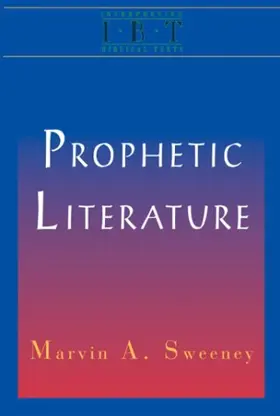

Prophetic Literature
in Interpreting Biblical Texts
Pages
216 pages
Publisher
Abingdon Press
Published
2/1/2006
ISBN-13
9780687008445
Reviews
Marvin Sweeney’s Ph.D. was received from the Claremont Graduate School in 1983, and his dissertation was published as Isaiah 1–4 and The Post-Exilic Understanding of the Isaianic Tradition (BZAW). His name is well known among scholars of the Hebrew Bible. Sweeney, along with Roy Melugin, has served in the past as joint chairman on working group entitled The Formation of the Book of Isaiah Seminar of the Society of Biblical Literature. A prolific author in the field of the Hebrew Bible, Sweeney has written numerous commentaries, monographs, and articles. A sampling of his works from the last decade reveals that Sweeney has written Isaiah 1–39, with an Introduction to Prophetic Literature (FOTL); The Twelve Prophets (with David Cotter, Jerome Walsh, and Chris Franke; Berit Olam); Reading and Hearing the Book of the Twelve (co-editor with James Nogalski; SBLSymS); King Josiah of Judah: The Lost Messiah of Israel; Ezekiel, Zadokite Priest and Visionary Prophet of the Exile; Zephaniah (Hermeneia); The Changing Face of Form Criticism for the Twenty-First Century (co-edited with Ehud Ben Zvi); and Form and Intertextuality in Prophetic and Apocalyptic Literature. The Prophetic Literature is a work in the ongoing series Interpreting Biblical Texts. Gene Tucker and Charles Cousar, co-editors, note “The aim of the series is clearly pedagogical.
[Full Review]
S’il est l’auteur d’un commentaire des XII prophètes (The Twelve Prophets [2 vols.; Collegeville, Minn.: Liturgical Press, 2000]), Marvin A. Sweeney est d’abord un spécialiste du livre d’Isaïe, auquel il a consacré en particulier une monographie remarquée (Isaiah 1–4 and the Post-Exilic Understanding of the Isaianic Tradition [BZAW 171; Berlin: de Gruyter, 1988]) et un commentaire (Isaiah 1–39 [FOTL 16; Grand Rapids: Eerdmans, 1996]). Il était donc particulièrement qualifié pour écrire une introduction générale à la littérature prophétique destinée à un large public cultivé. Contrairement à ce qu’on pourrait croire, la rédaction d’un tel ouvrage, qui doit aller à l’essentiel en peu de pages et faire preuve de pédagogie, requiert une grande maîtrise du sujet. Le livre est écrit dans un style clair et agréable. Il comporte sept chapitres. Les deux premiers traitent de questions générales: les prophètes dans les Écritures juives et chrétiennes (15–21), puis le monde des prophètes du Proche-Orient ancien et les genres littéraires prophétiques (23–44). Les quatre suivants sont consacrés aux grands recueils des “prophètes postérieurs”: Isaïe (45–84), Jérémie (85–125), Ézéchiel (127–64) et le livre des Douze prophètes (165–214). Le dernier chapitre a la forme d’un bref épilogue, qui souligne l’actualité des prophètes de jadis (215–19). Chaque partie se termine par une brève bibliographie, en langue anglaise uniquement.
[Full Review]
